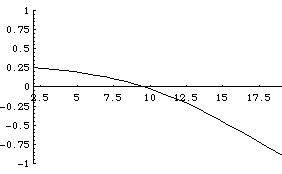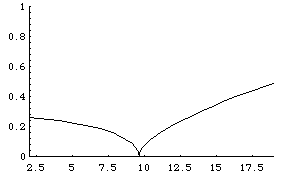
[ In 1998, after reading quant-ph/9806009 by Guang-jiong Ni, I realized that I made some errors in my 1992 calculation of the Higgs Vacuum Expectation Value and the Higgs mass, and I now calculate the Higgs Vacuum Expectation Value as about 260 GeV and the Higgs mass as about 145 GeV. However, I don't think that the general geometric/structural ideas were incorrect. ]
The Higgs mass mH renormalization effects are estimated here by Mathematica using the equation34
M dl / dm = (1/16¹^2) (12 l^2 + 6 l t^2 + (9/16)w^4 -(9/2)l w^2 - 3t^4)
where l is the Higgs scalar coupling, t is the truth quark Yukawa coupling, and w is the weak charge in units such that w^2 = aW:
The variables c, w, and e are the color, weak, and electromagnetic charges, using the unconventional convention that a = g2 rather than
a = g2 / 4¹ for charge g.
Then mH = vÃ(l/2) = 0.518 Ãl TeV in the F4 model, where
v = ( Ã2 / Ãaw ) ( mw+ + mw- + mw0 ) = 733 GeV
.
The results of this radiative correction to mH are shown here with l, in the first plot, and, in the second plot, mH in Tev plotted against logM in GeV:


mH = 261 GeV at M = 100 GeV;
mH = 0 at just below M = 10^10 GeV; and
|mH| = 480 GeV at M = 10^19 GeV.
Just below M = 10^10 GeV, l becomes negative so that mH is imaginary from just below 10^10 GeV to the Planck mass 10^19 GeV.
At the Planck mass, l = -1. Although in the F4 model the radiative corrections are calculated by running up from about 10^2 GeV, it is somewhat like starting at the Planck mass with a term l (FÝF)^2 + m^2 FÝF (with the same sign, so not Ginzburg-Landau); then running down, with the magnitude of l and the imaginary Higgs mass decreasing until they hit zero just below 10^10 GeV; and then the magnitude of l (now negative, so that
l (FÝF)^2 + m^2FÝF is of Ginzburg-Landau form and the Higgs mass is real) increasing until about 10^2 GeV, where l = +0.25 and
mH = 261 GeV. (Compare some supergravity theories such as described in §15.3 of the first edition of Mohapatra41, and in the corresponding section of its recent second edition.)
In any event, the magnitude of mH below the Planck mass is safely below any upper bound required of the F4 model by perturbation theory.
[ In 1998, after reading quant-ph/9806009 by Guang-jiong Ni, I realized that I made some errors in my 1992 calculation of the Higgs Vacuum Expectation Value and the Higgs mass, and I now calculate the Higgs Vacuum Expectation Value as about 260 GeV and the Higgs mass as about 145 GeV. However, I don't think that the general geometric/structural ideas were incorrect. ]